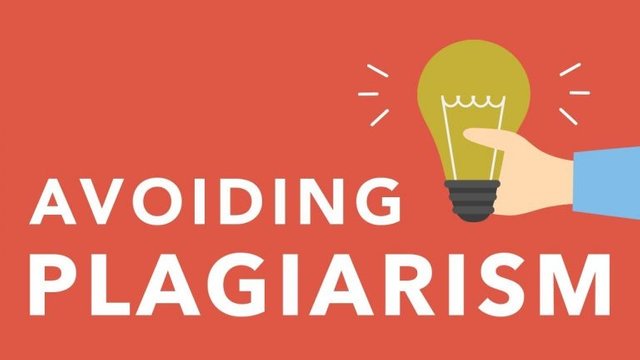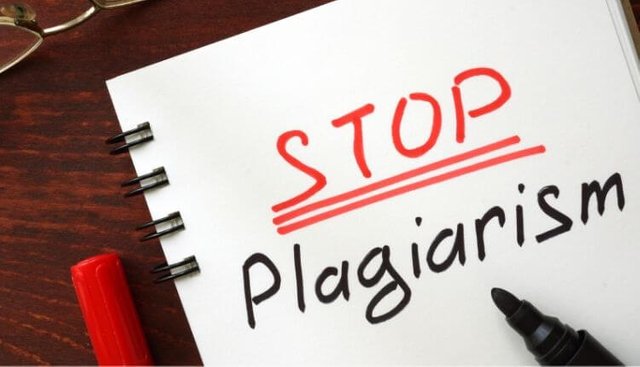Good day to all my fellow steemians, it's been a while as I once said "life can be very busy some times". Believe me I miss you guys soo much I trust we all are doing good all this while, am back with achievement 3 post.

https://www.timeshighereducation.com
From the very beginning I start to hear of " copy and paste" phrase, the first thing that came to my mind was that these two words has to do with the "original and photocopy" of a source item. But what I don't understand now is, it it even possible for this to be avoided?
Because the whole stuff of nowadays are full of such things. Humans in general are Soo lazy to sit back and crack their brains for a better community rather we plagiarize even our daily life...
https://sundial.csun.edu/138189
In this article, I will be sharing with us what copy-paste (plagiarism) is all about, types,side effects and how we can avoid it because it's actually avoidable...

Plagiarism means using someone else’s work without giving them proper credit. In academic writing, plagiarizing involves using words, ideas, or information from a source without citing it correctly.
Plagiarism can occur in many different contexts. While often associated with school assignments, it can also happen in professional settings, such as the arts, academia, and the business or even our daily life activities.
https://www.scribbr.com/category/plagiarism/
Types Of Plagiarism
We have quite a number types or ways to plagiarize work that's not ours In general.
But will like us to look at 4 others for now.
Among the different types of plagiarism. Direct plagiarism, mosaic plagiarism are the most common types of plagiarism. It is essential to know how to check plagiarism online to avoid it.
1-DIRECT Plagiarism: Most commonly, the crime of plagiarism involves adopting parts from the writing of another writer without proper mention of the source. Often the person copying from the text does not change even a single word. The plagiarist can also change parts of sentences or replace some of the words with his/her own. However, it also comes under the crime of plagiarism.
Among the different forms of plagiarism, direct plagiarism is the most harmful one. When the plagiarist copies and paste the text from someone else’s work and neglects to cite the source or remove quotation marks, then it is direct plagiarism.
The identical copying or cloning of a text is a severe offense. This duplicate content falls under the category of deliberately plagiarised content. It is unethical, and the writer of the original content can take disciplinary actions against the plagiarist.
2-MOSAIC Plagiarism: There is another type of plagiarism which is unintentional. In this case, the plagiarist may have mentioned the source of the content he has referred to. But, if he/she does not acknowledge the quoted part or put them under the quotation marks correctly, then the writer commits the crime of plagiarism.
Whether intended or unintended, plagiarism is a serious crime as it ensures writing to be the property of a writer.
3-SELF Plagiarism: Self-plagiarism is one of the common types of plagiarism, where high school students copy and paste part of their previously submitted academic paper. If the student submits the same paper for two different class projects without asking the concerned teacher, then that is considered as self-plagiarism.
Though self-plagiarism does not often end with serious legal action, that can affect the presentation for academic papers, research papers.
4-ACCIDENTAL Plagiarism: Another common form of plagiarism involves accidental plagiarism. When the plagiarist misquotes the phrases or parts of the text he/she has taken from the source material or does not cite the source even or adequately or cites a wrong source, they that is considered as plagiarism.
Accidental Plagiarism
For incorrect authorship, even though the name of the work gets cited, the original writer can take disciplinary actions against the plagiarist, even though accidental plagiarism in no way intended.https://copyleaks.com/blog/types-of-plagiarism
Side Effects; Why Is It Wrong To Plagiarize?
Plagiarism is unethical for three reasons:
-Firstly, it is unethical because it is a form of theft. By taking the ideas and words of others and pretending they are your own, you are stealing someone else’s intellectual property.
-Secondly, it is unethical because the plagiariser subsequently benefits from this theft.
-Thirdly, a degree is evidence of its holder’s abilities and knowledge. If a student gains employment on the basis of a qualification they have not earned, they may be a risk to others.
No doubt some students do cheat. They deliberately take the results of other people’s hard work, use it to gain credit for themselves, and learn little or nothing in the process. But most cases of plagiarism are accidental and could be avoided if students became more conscious of their own writing and research practices. Most students who plagiarise do so unintentionally, usually because they don't have the skills to avoid over-reliance on the work of others or because they aren't sure what constitutes plagiarism. Plagiarism allegations can cause a student to be suspended or expelled. Their academic record can reflect the ethics offense, possibly causing the student to be barred from entering college from high school or another college. Schools, colleges, and universities take plagiarism very seriously. Most educational institutions have academic integrity committees who police students. Many schools suspend students for their first violation. Students are usually expelled for further offences.
https://www.student.unsw.edu.au
How To Avoid Plagiarism

https://copyleaks.com/blog/types-of-plagiarism
Specially for writers; why and how should a writer avoid plagiarism?
To create an original piece of one’s own requires utmost dedication and hard work. These ultimately lead to the creation of unique content. Content or write up can be of several types, like school projects, thesis, research work, SEO for companies, and others. But at times, plagiarism becomes unintentional and accidental. So here’s to those aspirants who strive to avoid accidental plagiarism and produce plagiarism-free content.
Plagiarizing text for school, work assignments, and even your own creative work is sometimes easier than purposely plagiarizing and copying and pasting from one document to your own. Keep these tips in mind before, during, and after you write your own unique content to be sure you didn’t accidentally plagiarize.
-come up with your ideas
-use your language
-use citations
-create content with rich informations
-never miss the inners voice and style
Lastly
-always use plagiarism checker
https://copyleaks.com/blog/how-to-avoid-accidental
IN CONCLUSION

It's not easy as it is but trust me with persistent we can definitely avoid plagiarism in every aspect of our lives.....MJbest cares ◉‿◉
I have read and understood the Steemit Etiquette on Steemit Community and will do my best to embrace them.